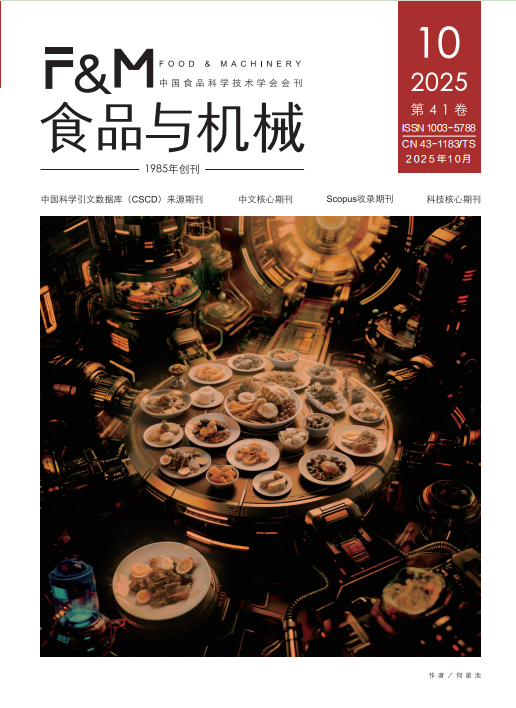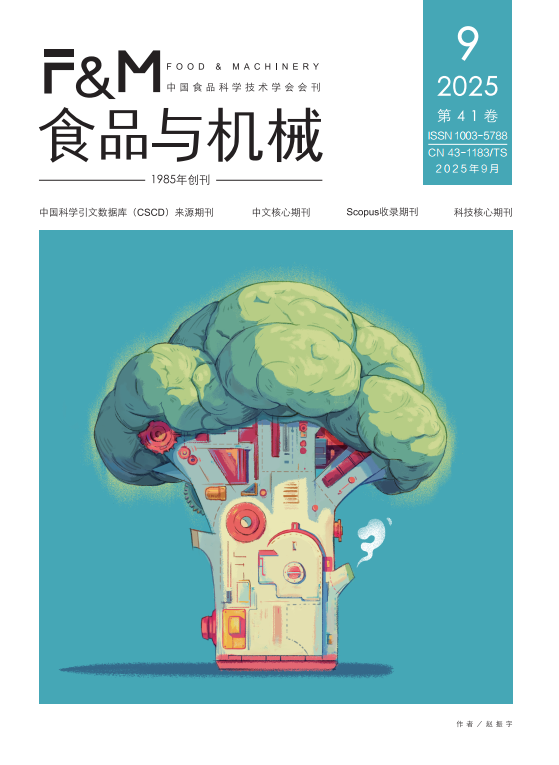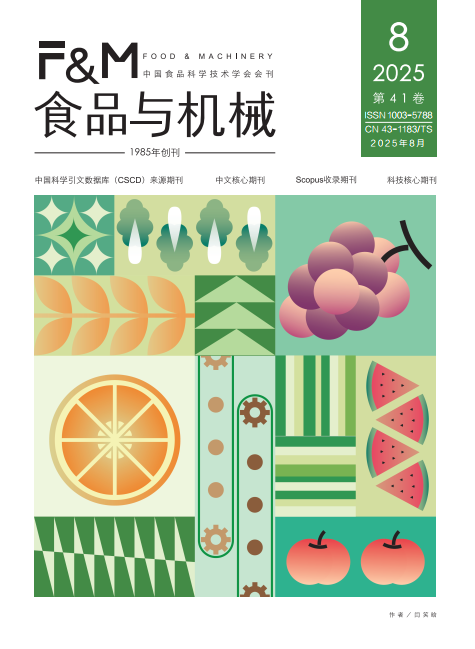 Information
Information
Governing Body Education Department of Hunan Province
Organizers Changsha Unversity of Science&Technology
EditingPublication 《食品与机械》编辑部
Domestic emailed code 42-83
Foreign emailed code MO3355
Domestic distribution 湖南省报刊发行局
Foreign sales 中国国际图书贸易集团有限公司
-
LI Yanchu, YANG Yuying, HU Weicheng, LIU Shucheng, WEI Shuai
2025 ,DOI: 10.13652/j.spjx.1003.5788.2025.80437
Abstract:
Objective To obtain recombinant tropomyosin (TM).Methods In this study, the gene sequence of a TM homologous protein is obtained from the National Center of Biotechnology Information (NCBI) database, and specific primers are designed accordingly. Subsequently, using the cDNA of Litopenaeus vannamei meat as the template, the TM coding gene sequence of L. vannamei is amplified by PCR and sequenced. Finally, the prokaryotic recombinant expression system for L. vannamei TM is established using the Escherichia coli heterologous recombinant expression vector pET29a.Results After agarose gel electrophoresis (AGE) of the RNA samples, the band is clear and bright, with no diffusion observed in the lanes. The cDNA sample displays a clear band around 300 bp, indicating successful extraction of the total RNA samples from L. vannamei meat with intact structures and subsequent reverse transcription into cDNA. The PCR results indicate a single band at 900 bp for the TM coding gene of L. vannamei. BLAST analysis of the gene sequence shows that the TM coding gene is highly homologous (99.77%) to the known TM coding gene of L. vannamei. This study further constructs the TM recombinant expression vector pET29a-TM. SDS-PAGE analysis confirms efficient expression of the target protein in the host strain, yielding a soluble recombinant TM protein band with a relative molecular weight of approximately 3.7×104.Conclusion This study successfully clones the TM coding gene from L. vannamei and constructs its prokaryotic expression system, enabling the efficient production of soluble recombinant TM protein.
-
ZHU Shuiwang, WANG Le, FAN Mingcong, LI Yan, QIAN Haifeng, WANG Li
2025 ,DOI: 10.13652/j.spjx.1003.5788.2025.60126
Abstract:
Objective This study aimed to investigate the functional characteristics of polyphenols from black soybean hulls (a by-product of black soybean) and their application in bread.Methods The polyphenol extracts were obtained from black soybean hulls via ultrasonic-assisted solvent extraction, followed by the isolation of free and bound polyphenols. The regulatory effect of these polyphenols on the starch digestion characteristics of bread was further analyzed.Results Free and bound polyphenols were isolated from polyphenols from black soybean hulls, with contents of 20.42 mg GAE/g and 9.47 mg GAE/g, respectively. The ABTS and DPPH radical scavenging rates of free polyphenols reached 88.85% and 80.04%, respectively. The addition of 0.25% polyphenol extracts decreased the rapidly digestible starch content in bread crumb and crust from 43.75% and 40.23% to 31.25% and 27.93%, respectively, while the resistant starch content increased to 45.32% and 50.59%, respectively. Molecular docking analysis revealed that components such as chlorogenic acid in polyphenols from black soybean hulls exerted competitive and noncompetitive mixed inhibition on α-glucosidase through hydrogen bonding and hydrophobic interactions.Conclusion Polyphenols from black soybean hulls can retard bread digestion by inhibiting α-glucosidase activity and modifying starch structure.
-
LI Rui, HUANG Hongyou, MAO Jie, ZHAO Wenbo, ZHAO Mingqin, PENG Juncang
2025 ,DOI: 10.13652/j.spjx.1003.5788.2025.80026
Abstract:
Objective To investigate the factors affecting the extraction rate, characteristic aroma components, and stability of Phyllanthus emblica L. extracts from different producing areas.Methods Five types of P. emblica from four producing areas, including Guangdong, Yunnan, Jiangxi, and Sichuan, were used as raw materials. Orthogonal experiments were conducted to study the effects of various factors on the extraction rate. Gas chromatography-mass spectrometry (GC-MS) analysis and similarity calculations were used to compare the characteristic aroma components of P. emblica extracts from different producing areas. The stability of the extracts was evaluated based on appearance, relative density, and sugar content.Results Among the producing areas, dried P. emblica from Yunnan had the highest extraction rate, with solvent and material-to-liquid ratio being the main factors influencing extraction. GC-MS analysis showed that characteristic aroma components of extracts from Guangdong included furfural, furfuralcohol, pyranone, 5-hydroxymethylfurfural, and ethyl palmitate, whereas extracts from Yunnan were characterized by 3-methyl-2-furanic acid and dibutyl phthalate. The similarity between these two extracts was only 0.943 6.Conclusion All five P. emblica extracts exhibited a prominent fruity-sweet aroma. However, there were significant differences in characteristic aroma components among different producing areas and varieties. The extracts also demonstrated good preservation and usage stability over a certain period.
-
ZHONG Ni, ZHAO Xi, YU Penghui, HUANG Hao, LI Na, ZHENG Hongfa
2025 ,DOI: 10.13652/j.spjx.1003.5788.2025.80052
Abstract:
Objective To realize the geographical discrimination of early spring green tea of Huangjincha from major production areas in Hunan based on mineral element fingerprinting.Methods A total of 138 early spring green tea samples of Huangjincha from different regions in Hunan were quantitatively analyzed for 48 mineral elements using inductively coupled plasma mass spectrometry (ICP-MS). Classification models for different production areas were developed by integrating principal component analysis (PCA), orthogonal partial least squares-discriminant analysis (OPLS-DA), and Fisher's linear discriminant analysis.Results The PCA score plots and OPLS-DA models effectively distinguished Huangjincha samples from various production areas in Hunan. A geographical discrimination model was constructed using Fisher's linear discriminant analysis based on 10 key elements (Ba, Al, B, Sm, K, Ga, Te, Rb, Co, Eu), achieving an overall prediction accuracy of over 90%.Conclusion Mineral element fingerprinting can be effectively applied to the origin traceability of Huangjincha from major production areas in Hunan.
-
2025 ,DOI: 10.13652/j.spjx.1003.5788.2025.80124
Abstract:
Objective To develop an ultra-high performance liquid chromatography-tandem mass spectrometry (UPLC-MS/MS) method for determining lutein and natural vitamin K (VK) homologues, including phylloquinone (VK1), menaquinone-4 (MK-4), menaquinone-7 (MK-7), and menaquinone-9 (MK-9), in poultry eggs by optimizing ultrasound assisted enzymatic hydrolysis.Methods The target compound is extracted from poultry egg samples by ultrasound assisted enzymatic hydrolysis and then separated on C18 (100 mm×2.1 mm, 3.0 μm) column with 0.1% formic acid aqueous solution-0.1% formic acid methanol for gradient elution. Meanwhile, the samples are quantified by external standard with APCI source for detection and analysis.Results Under the ultrasound assisted enzymatic hydrolysis conditions of enzyme dosage of 1 500 U and hydrolysis time of 1 hour, the linear relationships of lutein and natural VK homologues are good in the range from 1.0 ng/mL to 5 000 ng/mL (R2>0.996). The detection limit is 0.8~1.5 μg/100 g, and the quantification limit is 2.0~5.0 μg/100 g. The average recovery of lutein and natural VK homologues is 80.1%~94.9% when the spiked concentration is 10, 20, and 100 μg/100 g with the RSD of 1.3%~5.5%.Conclusion This method has high detection efficiency, sensitivity, and selectivity and can be used as a detection method for lutein and natural VK homologues in poultry eggs.
-
2025 ,DOI: 10.13652/j.spjx.1003.5788.2025.60144
Abstract:
From the perspective of China's criminal law practices and their effectiveness in addressing food safety issues, the main deficiencies in the current criminal regulation of food safety in China are manifested in three areas: the unreasonable classification of offenses within chapters, the absence of provisions for negligent crimes, and the lack of a mandatory qualification penalty, along with the rigidity of the prohibition order. In response, this article proposes improvement to the current criminal regulation of food safety by reasonably determining the classification of offenses within chapters, scientifically adding specific provisions for negligent crimes, and optimizing the design of the qualification penalty and prohibition order within the criminal punishment system.
-
2025 ,DOI: 10.13652/j.spjx.1003.5788.2025.60145
Abstract:
Civil Code, Law of the People's Republic of China on the Protection of Consumer Rights and Interests, and Food Safety Law of the People's Republic of China have all made specific provisions for the punitive damages system in criminal incidental civil public interest litigation in the food field. However, there are still difficulties such as unclear calculation bases for punitive damages, a lack of sufficient rationality in the amount of punitive damages, a poor connection between punitive damages, criminal fines, and administrative fines, and certain deficiencies in the management and use mechanism of punitive damages. In this regard, we can overcome the current difficulties by clearly defining the calculation base of punitive damages, reasonably determining the amount of punitive damages, improving the connection mechanism between punitive damages, criminal fines, and administrative fines, and optimizing the management and use mechanism of punitive damages.
-
ZHANG Han, ZHANG Minyu, ZHAO Huachao, LI Bing, WU Zhonghua
2025 ,DOI: 10.13652/j.spjx.1003.5788.2025.80115
Abstract:
Objective To investigate the enhancement effect of self-excited thermoacoustic oscillation on the drying process of solid foods.Methods A pulsating hot air drying device based on a Rijke tube resonator structure is designed. White radish slices are selected as the target material to study the effects of hot air temperature (100~140 ℃), airflow velocity (1~7 m/s), and layer thickness (4~12 mm) on drying kinetics and product quality.Results The device can stably generate a self-excited pulsating airflow with a temperature of 140 ℃, frequency of 147 Hz, and sound pressure level of 94 dB, which significantly improves drying efficiency compared to traditional non-pulsed drying methods. Under a 100 ℃ working condition, the drying time is reduced from 165 min to 135 min (an 18% decrease), and the enhancement effect increased with temperature (at 140 ℃, the drying rate tripled). With optimized parameters (100 ℃, 1 m/s airflow, 8 mm material thickness), the shrinkage rate (67%), rehydration ratio (4.66), and whiteness (70.18) of the white radish slices are improved compared to conventional drying.Conclusion Thermoacoustic oscillation enhances heat and mass transfer efficiency by periodically disturbing the thermal boundary layer, while also reducing structural damage to the material caused by high temperatures.
-
FANG Qiang, FENG Zuoshan, BAI Yujia, ALIMIRE Yibulayin, YAN Yahui
2025 ,DOI: 10.13652/j.spjx.1003.5788.2025.80180
Abstract:
Objective To explore novel distillation equipment and address the adverse effect of burnt tastes in the wines caused by excessively high distillation temperatures of traditional equipment.Methods Three types of low-temperature distillation equipment, self-developed in the laboratory, along with pot distillation equipment, are used to distill jujube wines. The volatile components in the crude distilled jujube wines are analyzed using gas chromatography-mass spectrometry (GC-MS).Results A total of 74 compounds are identified in the crude distilled jujube wines, including 44 esters, 8 alcohols, 5 acids, 6 aldehydes, 4 ketones, and 7 other compounds. An orthogonal partial least squares discriminant analysis (OPLS-DA) model is established with a classification prediction accuracy of 95.0% to screen 13 differential volatile components of variable importance in projection (VIP)>1. Based on the relative odor activity value (ROAV) analysis, 9 key aroma compounds (1≤ROAV≤100) are identified, reflecting certain differences in aroma substances among the different crude distilled wines.Conclusion In substance content, the crude distilled wines from the low-temperature distillation equipment contain significantly more esters and alcohols than those from the pot distillation equipment, while producing lower ketones and acids. Sensory evaluation reveals certain differences between the wines obtained from low-temperature and high-temperature distillation processes.
-
YE Linlin, LIU Zhaoqiang, WU Yunmei, LI Yueqing
2025 ,DOI: 10.13652/j.spjx.1003.5788.2025.60068
Abstract:
Objective To further enhance the intelligence level of food production, and address the issues of insufficient flexibility and operation accuracy of existing Delta robots for food sorting in applications, thus improving the overall efficiency of food production lines and product quality stability.Methods Based on the intelligent food production system, a trajectory optimization and tracking method for intelligent food production robots is proposed, which integrates multi-objective trajectory optimization and adaptive fuzzy sliding mode control (AFSMC). Firstly, a multi-objective (energy consumption and operation time) optimization model is built. Next, the model is solved through an improved particle swarm algorithm to generate the optimal motion trajectory that balances efficiency and energy consumption. Then, real-time tracking control of the optimized trajectory is performed through fuzzy adaptive control to ensure the motion accuracy of the robot in complex working conditions. Finally, the performance of the proposed method is validated by a food sorting experimental platform.Results Compared with traditional trajectory control methods, the proposed method reduces the energy consumption by >3% and shortens the single operation time by >3%, with a trajectory tracking error <0.5 mm. Additionally, the proposed model can maintain stable operating accuracy and flexibility in complex scenarios, such as different food shapes and conveyor belt speed.Conclusion Through the collaborative application of multi-objective trajectory optimization and fuzzy adaptive control, the proposed method effectively addresses the issues of low flexibility and accuracy of existing food production robots, significantly reducing energy consumption and operation time.
-
LIU Chunshan, LI Zhiang, DENG Wenbin, SHANG Tao, XIAO Xuecai
2025 ,DOI: 10.13652/j.spjx.1003.5788.2024.81250
Abstract:
Objective To achieve accurate and efficient detection of pig carcasses' segmentation features, which are hard to distinguish and relatively small.Methods The Ghost Conv module and C3Ghost module are introduced into the Backbone layer to replace the ordinary convolution and C2 modules in the original YOLOv8n feature extraction network, aiming to reduce the computational amount and model complexity. The SPPF module is replaced with the SPPELAN module, so that the model can more effectively cope with multi-scale and small target features. Finally, parameter-free attention SimAM is introduced in front of the three detection heads to improve the ability to recognize the small target features of the lower pig carcass in a complex environment.Results The mAP50 of the improved YOLOv8n model on the self-made dataset is 97.3%, which is 5.3% higher than that of the original YOLOv8n. The parameter Params, computational FLOPs, and the model size of the improved model are 1.5 M, 4.9 G, and 3.5 MB, respectively, which are only 50.0%, 60.5% and 55.6% of YOLOv8n. The FPS of the model inference speed is 120.2 frames/s, which is increased by 20.7 frames/s.Conclusion The improved YOLOv8n model has advantages in detection accuracy and lightweight, and can effectively identify the small target segmentation features of pig carcasses.
-
LI Jianjia, WANG Yongqiang, ZHOU Congling, WANG Hao
2025 ,DOI: 10.13652/j.spjx.1003.5788.2025.80003
Abstract:
Objective To address the low speed and efficiency as well as missed and false detection in manual inspection of defective products in pre-fried potato chip production, enhance the accuracy and speed of product defect identification, and ensure safe production.Methods An improved recognition algorithm, EISW-YOLOv8n, based on YOLOv8n is proposed. Firstly, the efficient multiscale channel attention (EMCA) mechanism is introduced into the network to highlight important channel information. Secondly, to improve the model ability to extract features and capture long-distance dependencies within features, the iRMBS module, optimized by SWC convolution, is introduced into the C2f module. Finally, the loss function WIOU is introduced to enhance the localization accuracy of the prediction box and the convergence speed of the model.Results The proposed model achieves the average precision of 94.3% for defect detection in pre-fried potato chips. Compared with the original YOLOv8n model and common object detection algorithms, this network demonstrates superior performance.Conclusion EISW-YOLOv8n can meet the requirements for identifying appearance defects in pre-fried potato chips.
-
YUAN Chi, WANG Yujie, HUANG Zhanrui, HU Lianhua, HE Wanying, CHEN Hao
2025 ,DOI: 10.13652/j.spjx.1003.5788.2025.80545
Abstract:
Objective This study developed a preservation process for leisure dried tofu (LD-tofu) by using natural antimicrobial agents, Surfactin and linalool, to replace chemical preservatives.Methods The minimum inhibitory concentration (MIC) of Surfactin and linalool was determined with Bacillus subtilis as the indicator bacteria, and aerobic plate count and sensory score were used as the evaluation indicators to optimize the optimal preservation process parameters of linalool and Surfactin for LD-tofu through single-factor and response surface experiments, and the quality changes of LD-tofu during storage were analyzed.Results The minimum inhibitory volume fraction of linalool was 1.95 μL/mL, and the MIC of Surfactin was 125 μg/mL, respectively. The optimal preservation process parameters of linalool and Surfactin for LD-tofu were Surfactin concentration of 187.5 μg/mL, linalool volume fraction of 2.2 μL/mL, treatment time of 30 min, and material-liquid ratios of 1∶3 (g/mL). Under these conditions, the shelf life of LD-tofu at 25 ℃ could be extended from 2 to 4 weeks. The aerobic plate count within 4 weeks at 4 ℃ could be lower than the detection limit, significantly slowing down the degradation of protein (decrease by 4.09%) and fat (decrease by 6.97%) and inhibiting the production of malondialdehyde (decrease by19.9% compared with the control group).Conclusion Linalool combined with Surfactin can effectively inhibit bacteria and delay the quality deterioration of LD-tofu.
-
ZHANG Xuesong, HONG Yi, GU Rongrong, GAO Daxiang, LI Jiaxin
2025 ,DOI: 10.13652/j.spjx.1003.5788.2025.80098
Abstract:
Objective To develop a novel packaging film to prolong the shelf life of fruits and vegetables and improve the utilization of enoki mushroom.Methods Silver nanoparticles (AgNPs) were green-synthesized using enoki mushroom water extract as the reducing agent, polyvinyl alcohol (PVA) as the dispersant, and silver nitrate solution as the silver source. A PVA-AgNP composite film with a hydrophobic surface was prepared and applied for the preservation of Hericium erinaceus.Results The optimal conditions for AgNP synthesis were pH 13, 2 g of enoki mushroom water extract, 2 g of PVA, 0.20% final concentration of silver nitrate solution, and 60 s microwave treatment. FT-IR, SEM, TEM, XRD, and contact angle analyses showed that the prepared AgNPs exhibited distinct characteristic silver crystal diffraction peaks, had interactions with the PVA film matrix, and were well dispersed within it. The composite film successfully formed a hydrophobic surface with a contact angle of 137.3°.Conclusion During H. erinaceus storage, measurements of weight loss, vitamin C content, browning degree, peroxidase (POD), and catalase (CAT) activities demonstrated that the prepared PVA-AgNP composite film effectively improved preservation quality, exhibiting good preservation effects and promising potential applications.
-
ZHANG Jie, ZHENG Wancai, DANG Bin, YANG Xijuan, GUO Junling
2025 ,DOI: 10.13652/j.spjx.1003.5788.2025.80043
Abstract:
Objective To improve the polyphenol utilization and antioxidant activity of black highland barley.Methods Black highland barley was treated using ultrasonic treatment (UT), microwave treatment (MT), and ultraviolet irradiation treatment (UVT). The differences in basic nutritional components, phenolic content, phenolic composition, and antioxidant activity were comparatively analyzed.Results Compared with the untreated group, the fat content of black highland barley significantly increased (P<0.05) after all three treatments, while the fiber content significantly decreased (P<0.05). The total phenolic and total flavonoid content were significantly increased (P<0.05) by all three treatments, reaching 1.03~1.19 times and 1.24~1.46 times those of the untreated group, respectively. Among them, UT significantly enhanced polyphenol content in black highland barley, increasing total phenolics and total flavonoids by 18.72% and 46.22%, respectively. UVT mainly increased hydroxycinnamic acids and flavonols, UT primarily increased flavonoids and flavanols, while MT mainly increased hydroxybenzoic acids. The antioxidant potency composite index (APC) of black highland barley treated by the three methods ranked as follows: UT (99.94%)>UVT (93.35%)>MT (82.91%)>CK (74.10%). There was a strong correlation between phenolic compounds and antioxidant activity.Conclusion UT resulted in the highest phenolic content and antioxidant activity in black highland barley.
-
LIU Chang, LI Cuisi, LIN Wanling, LUO Donghui, ZHENG Xinyi, CUI Xiaotong
2025 ,DOI: 10.13652/j.spjx.1003.5788.2024.81143
Abstract:
Objective To analyse the quality evaluation methods for and nutrition evaluation of recombinant goose liver products.Methods Goose liver is used as the raw ingredient and combined with chicken breast, while tapioca starch, soybean protein isolate, and transglutaminase (TG) are added as auxiliary materials, to prepare recombinant goose livers. The CRITIC-grey correlation analysis is employed to comprehensively score the color, cooking loss, and texture characteristics of recombinant goose livers made with different formulas. Then, the best formula is screened for nutritional index observation and nutrition evaluation.Results The comprehensive score of recombinant goose livers is the highest at 208.93 with 15% goose livers, 85% chicken breast, 1.25% TG, 10% tapioca starch, and 2.5% soybean protein isolate. The moisture, protein, and fat content of recombinant goose livers are 64.86, 18.13, and 0.85 g/100 g, respectively. A total of 14 fatty acids are detected, including 9 unsaturated fatty acids and 5 saturated fatty acids, including linoleic acid, α-linolenic acid, and arachidonic acid. More importantly, the atherosclerosis index (AI) and thrombosis index (TI) are lower than 0.5. Additionally, essential amino acids/amino acids (EAA/TAA) and essential amino acids/nonessential amino acids (EAA/NEAA) are 43.25% and 76.22%, respectively, with methionine as the first limiting amino acid.Conclusion The quality of recombinant goose livers is evaluated using the CRITIC-grey correlation analysis, which can reflect the quality characteristics of recombinant goose livers. Recombinant goose liver is a high-protein, low-fat food suitable for patients with cardiovascular and cerebrovascular diseases. Reasonably in amino acid composition, recombinant goose liver is a source of high-quality protein.
-
FENG Yan, GAO Yuhui, ZHANG Mengna
2025 ,DOI: 10.13652/j.spjx.1003.5788.2024.80753
Abstract:
Objective To investigate the regulatory effect of Auricularia auricular protein-polysaccharide complex (PPC) on lead (Pb) excretion in mice under co-cage rearing.Methods Sixty Kunming mice were randomized into blank control (NC), model (Pb), PPC, Co-Pb, and Co-PPC groups. After 8 weeks of feeding, the concentrations of red blood cells and hemoglobin are measured by a fully automated hematology analyzer. ICP-MS is employed to determine the Pb content in the whole blood, small intestine, and feces of mice. The ELISA kit is used to measure the content of lipopolysaccharides (LPS) in the serum and the levels of lysozymes, β-defensins, and sIgA in the small intestine.Results Compared with the NC group, the Pb group has increased levels of Pb in the blood, small intestine, and feces and LPS in the serum (P<0.05) and decreased red blood cell count, hemoglobin concentration, and levels of lysozymes, β-defensins, and sIgA (P<0.05). Compared with the Pb group, the Co-Pb group shows decreases in Pb content in the blood and small intestine (P<0.05), increases in the hemoglobin concentration and fecal Pb content (P<0.05), and insignificant increases in red blood cell count and levels of lysozymes, β-defensins, and sIgA. The PPC and Co-PPC groups show declines in the levels of LPS in the serum and Pb in the blood and small intestine (P<0.05), elevations in the hemoglobin concentration, fecal Pb content, and levels of lysozymes, β-defensins, and sIgA (P<0.05), and no significant difference in red blood cell count.Conclusion PPC can promote Pb excretion and improve blood and small intestine conditions in mice.
-
SHI Jiacheng, WU Yingying, SHEN Cunkuan, ZHANG Huien, YANG Hua
2025 ,DOI: 10.13652/j.spjx.1003.5788.2025.80078
Abstract:
Objective To develop a novel functional rice cake with enhanced nutritional value and improved flavor, achieving a health-conscious modification of traditional rice cake formulation.Methods Japonica rice flour was used as the base substrate, supplemented with co-fermentation of plant lactic acid bacteria and brewing yeast. The composite ratio of flaxseed meal (7%) and chickpea meal (5%) was optimized by single-factor experiments combined with principal component analysis (PCA). The effects of the improved formulation on product quality, nutritional composition, in vitro digestion characteristics, antioxidant activity, and flavor profile were systematically evaluated.Results The optimized rice cake maintained whiteness while total phenolic content increased threefold, and DPPH and ABTS+ radical scavenging rates doubled. Slowly digestible starch and resistant starch content significantly increased, with an estimated glycemic index (eGI) reduced to 53.758, meeting low glycemic index food standards. Nutritional analysis revealed a 1.105 g/L increase in protein content, with significant decreases in cholesterol and starch. Gas chromatography-mass spectrometry (GC-MS) combined with orthogonal partial least squares discriminant analysis (OPLS-DA) demonstrated that the formulation effectively reduced fermentation acidity and introduced characteristic flavor compounds such as isobutanol.Conclusion The flaxseed-chickpea composite technology significantly enhances the nutritional value and antioxidant properties of the rice cake, optimizes digestive metabolic performance, and improves flavor characteristics.
-
LI Jinian, GUO Jia, JIA Yibin, MA Mengjie, WANG Ye, CHEN Lishui
2025 ,DOI: 10.13652/j.spjx.1003.5788.2024.81236
Abstract:
Objective To evaluate the taste quality of boxed instant rice prepared on industrial microwave cooking production line with eight kinds of rice, including japonica rice and indica rice.Methods Not only composition, cooking quality, and gelatinization characteristics of raw rice are tested, but also taste value, hardness, viscosity, sensory scores, and the microstructure are detected to evaluate the taste quality of different rice varieties.Results There are significant differences in the properties of different rice varieties. Compared with indica rice, japonica rice has lower average content of protein (by 0.76 g/100 g) and amylose (by 0.85 g/100 g), a higher average dry matter content in rice soup (by 4.27 mg/g), a higher average iodine blue value (by 0.21), a lower average gelatinization temperature (by 3.39 ℃), a lower average retrogradation value (by 74.5 Pa·s), and a lower average value of breakdown (by 145 Pa·s). The japonica rice has better thermal gelatinization stability, which is easier to gelatinize and not easy to retrograde. After microwave cooking, compared with indica rice, japonica rice has higher average hardness (by 9.77 N), higher average viscosity (by 2.28 N), a higher average taste value (by 6.87 points), and a higher sensory score (by 2.73 points). Considering the taste values and sensory scores of the rice comprehensively, Longjing 31 among japonica rice performs the best, with its microstructure presenting a honeycomb structure with relatively uniform pores.Conclusion Boxed instant rice prepared by industrial microwave processing has good taste quality, and japonica rice is more suitable for microwave processing than indica rice.
-
CHEN Yalan, CHEN Shunxin, HOU Heli, CHEN Weili, ZHU Jing
2025 ,DOI: 10.13652/j.spjx.1003.5788.2024.80825
Abstract:
Objective To improve the transformation of functional components in the Euryale ferox by microbial solid-state fermentation.Methods Euryale ferox is taken as the raw material to screen out the dominant strains, with the total flavonoid and total polyphenol content as indicators. Then, orthogonal experiments are conducted on the dominant bacteria to investigate the effects of fermentation temperature, fermentation time, material-liquid ratio, inoculation amount, and carbon source addition amount on the active components of the fermented Euryale ferox. The in vitro antioxidant activity of Euryale ferox is analyzed, with DPPH free radical scavenging rate, total antioxidant activity, and ABTS free radical scavenging rate as indicators.Results The dominant bacterium is Aspergillus niger H, and the optimal fermentation condition is as follows: fermentation time 5 days, fermentation temperature 35 ℃, material-liquid ratio of 1∶2 (g/mL), inoculation amount of 11%, and carbon source addition amount of 2%. Under these conditions, the total flavonoid content is 9.036 mg/g, which is 6.24 times higher than that of the unfermented one, and the total polyphenol content is 109.284 mg/g, which is 4.68 times higher than that of the unfermented one. The IC50 values of DPPH and ABTS free radical scavenging rates of fermented Euryale ferox are 0.023 and 0.024 mg/mL, respectively. The reducing ability of vitamin C positive control to iron ions is basically the same as that after fermentation, and is higher than that before fermentation.Conclusion It is feasible to use microbial to ferment the raw materials of Euryale ferox, which improves the extraction content and antioxidant activity of its active ingredients, demonstrating an ideal application prospect.
-
FANG Ronghui, WANG Qianhui, PANG Jie, YAN Zhiming
2025 ,DOI: 10.13652/j.spjx.1003.5788.2024.81071
Abstract:
Objective To employ macroporous resin for deodorization of kelp pulp.Methods The effects of macroporous resin type, deodorization temperature, and deodorization time on the deodorization of kelp pulp are explored through single-factor experiments, with the results of headspace-solid-phase microextraction/gas chromatography-mass spectrometry (HS-SPME/GC-MS) as an indicator. An electronic nose is used to analyze the differences in flavor of kelp pulp before and after the deodorization with macroporous resin.Results The optimal deodorization process for kelp pulp is deodorization with 7.3% AB-macroporous resin at 51 ℃ for 2 h. At these conditions, the removal rates of alcohols, aldehydes, and ketones in kelp pulp reach 44.98%, 47.1%, and 30.31%, respectively, and that of fishy substances reaches 51.6%. The electronic nose detection results show a significant difference in flavor of kelp pulp before and after the deodorization with macroporous resin.Conclusion AB-8 macroporous resin could effectively remove fishy substances and significantly improve the flavor of kelp pulp.
-
YAN Liqiang, YI Yuwen, XIONG Yiling, HOU Zhiyong, QIAO Mingfeng
2025 ,DOI: 10.13652/j.spjx.1003.5788.2024.80556
Abstract:
Objective To explore the effect of different roasting durations on the volatile flavor substances of red oil pepper.Methods Sensory evaluation, electronic nose, and gas chromatography-mass spectrometry (GC-MS) were used to analyze the sensory characteristics, color difference, and volatile compounds of red oil pepper roasted for different durations (0, 30, 45, 60, 75, and 90 s). Relative odor activity value (ROAV) and partial least squares discriminant analysis (PLS-DA) were employed to identify the key flavor compounds in the six types of red oil pepper.Results The overall flavor of red oil pepper prepared for different durations showed significant differences. A total of 63 volatile compounds were identified by GC-MS. ROAV analysis revealed that the overall aroma of red oil pepper was mainly composed of oily, cocoa, and onion aromas. PLS-DA screening identified 24 differential volatile compounds, with alcohols and aldehydes being the main ones.Conclusion Roasting time has a considerable impact on the color difference, sensory characteristics, and volatile flavor substances of red oil pepper. Red oil pepper roasted for 60 s exhibited better overall flavor and can be directly used in subsequent production and processing.
-
HAN Yumeng, XIN Yuan, HE Xinyi, ZHANG Sumei, LIAO Zhenyu
2025 ,DOI: 10.13652/j.spjx.1003.5788.2025.80585
Abstract:
Objective To investigate the effects of siritch-corn oil ratio on walnut cake quality.Methods Gradient experiments were conducted to analyze the sensory and physicochemical characteristics of walnut cake. Quality under different ratios was comprehensively assessed using sensory evaluation, texture analysis, electronic nose measurements, and gas chromatography-mass spectrometry (GC-MS), combined with determination of moisture content, acid value, and peroxide value.Results When the siritch-corn oil ratio was 1∶1, walnut cake achieved the highest sensory score of 82.8, exhibiting golden color (high L* and b* values), rich aroma, balanced texture, excellent moisture uniformity, and the highest semi-bound water content, effectively enhancing the characteristic flavor of siritch. Oxidative stability analysis showed that when the ratio exceeded 1∶1, both acid value and peroxide value increased significantly.Conclusion The optimal siritch to-corn oil ratio is 1∶1, which preserves the traditional flavor of walnut cake while improving its nutritional value.
-
JI Xin, ZHANG Yuhang, HUANG Weining, HE Shan, TANG Xiaojuan
2025 ,DOI: 10.13652/j.spjx.1003.5788.2025.80051
Abstract:
Kluyveromyces marxianus is a GRAS-classified fungal microorganism, renowned for its capacity to generate both conventional and specialized enzymes, as well as its function as a vector for the expression of specific enzymes. In the food industry, K. marxianus serves as a fermentation agent capable of effectively controlling the fermentation process and significantly enhancing the quality of fermented foods. This article systematically analyzes the microbiological characteristics of K. marxianus, reviews its application in the fermentation of products such as fruits and vegetables, dairy, grains, meat products, and alcoholic beverages, and explores its potential application in the future food industry.
-
DAI Nana, CHEN Jun, SHUAI Xixiang, HAN Jialong, DAI Taotao
2025 ,DOI: 10.13652/j.spjx.1003.5788.2024.81045
Abstract:
In recent years, plant proteins have become highly sought-after ingredients in health foods due to their wide range of sources, high nutritional value, low cost, and minimal environmental pollution. Bamboo shoot protein is abundant in resources and features a well-balanced amino acid composition. It possesses good solubility, oil-holding capacity, foaming ability, antioxidant activity, and anti-tumor activity, playing a significant role in the prevention and treatment of cardiovascular diseases, cancer, and other illnesses. However, under the conventional processing model from harvesting to final product, a large quantity of inedible by-products is discarded, and the complex high-fiber structure of bamboo shoots severely hinders protein extraction. This article reviews the research progress on the extraction methods, physiological activities, and applications of bamboo shoot protein, with a focus on summarizing the advantages and disadvantages of existing extraction techniques, and points out the future research challenges in this field.
-
LI Shanyu, FAN Xinyu, SHE Xiangqian, HE Qiuxing
2025 ,DOI: 10.13652/j.spjx.1003.5788.2024.81291
Abstract:
Nostoc sphaeroides kützing is a freshwater wild blue algae that has gained significant attention due to its unique nutritional value and multiple biological activities. Nostoc sphaeroides kützing contains a variety of nutritional components, including polysaccharides, proteins, amino acids, fatty acids, vitamins, and mineral elements. It has demonstrated antibacterial, anticancer, lipid-lowering, and antioxidant effects. This article systematically reviews the extraction methods, structural characteristics, biological activities, and applications of Nostoc sphaeroides kützing polysaccharides, and provides an outlook on its future research directions.
-
2025 ,DOI: 10.13652/j.spjx.1003.5788.2024.81148
Abstract:
Camellia seed oil, valued for its nutritional and economic benefits, is frequently adulterated with lower-grade oils. Additionally, its quality is influenced by multiple factors, including cultivar, geographical origin, and extraction techniques. This review systematically evaluates key analytical indexes for camellia seed oil authentication, focusing on sensory characteristics, physicochemical characteristics, spectral recognition characteristics, and comparison with different methods. From an integrated perspective of identification indexes, collection methods, and identification logic, this paper reviews the research progress of portable UV spectrometers (particularly fiber-optic-based systems) in technical performance and application scope.
-
HE Gangjian, ZENG Shuiling, LIN Fangcong, XIANG Shuo, ZHANG Jiaxiong
2025 ,DOI: 10.13652/j.spjx.1003.5788.2024.81107
Abstract:
Objective To improve the accuracy of liquor packaging defect detection.Methods A detection model based on an improved YOLOv8n is proposed. The ADown module is introduced into the model to effectively reduce parameter count and computational load while maintaining the original feature extraction capability. Large separable kernel attention (LSKA) is integrated into the spatial pyramid pooling fusion (SPPF) structure to further enhance the model's ability to capture and extract multi-scale features. In addition, the original CIOU loss function is replaced with the Inner-WIoU loss function, which combines Inner-IoU and Wise-IoU, thereby improving detection accuracy and accelerating model convergence.Results On a self-built liquor packaging dataset, the improved YOLOv8n model achieves an average precision of 86.4%, representing a 5.2% improvement over the original model. Moreover, the parameter count is reduced by 4.9%, and computation is reduced by 6.6%.Conclusion The model can meet the real-time detection requirements of liquor packaging.
-
SONG Hao, FENG Xiyao, WEI Jiayi, LIU Xuanrong, LU Naiyan
2025 ,DOI: 10.13652/j.spjx.1003.5788.2025.80307
Abstract:
Objective To develop an active edible film based on soy protein isolate (SPI), whey protein concentrate (WPC), and Arctium lappa L. polysaccharide (ALP) by using the casting method.Methods This study characterizes the surface morphology, tensile strength (TS), elongation at break (EAB), water solubility (WS), moisture content (MC), water vapor permeability (WVP), and light transmittance of the composite film. It also systematically investigates the impact of different ALP proportions on film properties. The optimal ratio for the film is identified, and its performance in Morchella preservation is evaluated.Results When the mass ratio of SPI/WPC to ALP is 1.0∶0.2, the SPI/WPC/ALP film shows significantly enhanced mechanical properties, barrier performance, and light transmittance (P<0.05). In the Morchella preservation experiment, this film effectively reduces the loss of phenolic substances, decreases tyrosine and malondialdehyde (MDA) levels, mitigates browning, and improves the quality and shelf life of Morchella.Conclusion The SPI/WPC/ALP composite film is a promising eco-friendly packaging material with potential applications in edible fungus preservation.
-
LIU Yajuan, XU Heng, QI Yanling, CAI Hui
2025 ,DOI: 10.13652/j.spjx.1003.5788.2025.60136
Abstract:
As an important carrier of traditional Chinese culture, intangible cultural heritage (ICH) handicrafts embody unique cultural connotations and emotional resonance in food packaging. However, current applications of ICH often suffer from superficial cultural connotations, static packaging presentation, and limited interactive engagement. This study focuses on the cultural connotations of ICH crafts and aligns it with the aesthetic principles of contemporary food packaging design. It proposes a three-tiered integration strategy comprising cultural perception-interactive experience-emotional belonging, supported by a systematic design methodology encompassing symbol reconstruction, media adaptation, and emotional embedding. By employing intelligent visual technologies such as generative AI (AIGC), augmented reality (AR), and digital design tools, the study implements a practical food packaging design to verify the feasibility of the proposed integration strategy.
-
2025 ,DOI: 10.13652/j.spjx.1003.5788.2025.80002
Abstract:
This paper explains the current problems and challenges faced by fruit and vegetable industry in China, and proposes the solution strategies of functional extension design for fruit and vegetable packaging. The methods and processes of fruit and vegetable packaging functional extension design are summarized from the four dimensions of packaging vision, structure, material and technology by systematically analyzing the theoretical research and excellent design cases of fruit and vegetable packaging functional extension in China and abroad, and are applied to the packaging design practice of seasonal fruit litchi.
 Author Login
Author Login Editor Login
Editor Login Reviewer Login
Reviewer Login website login
website login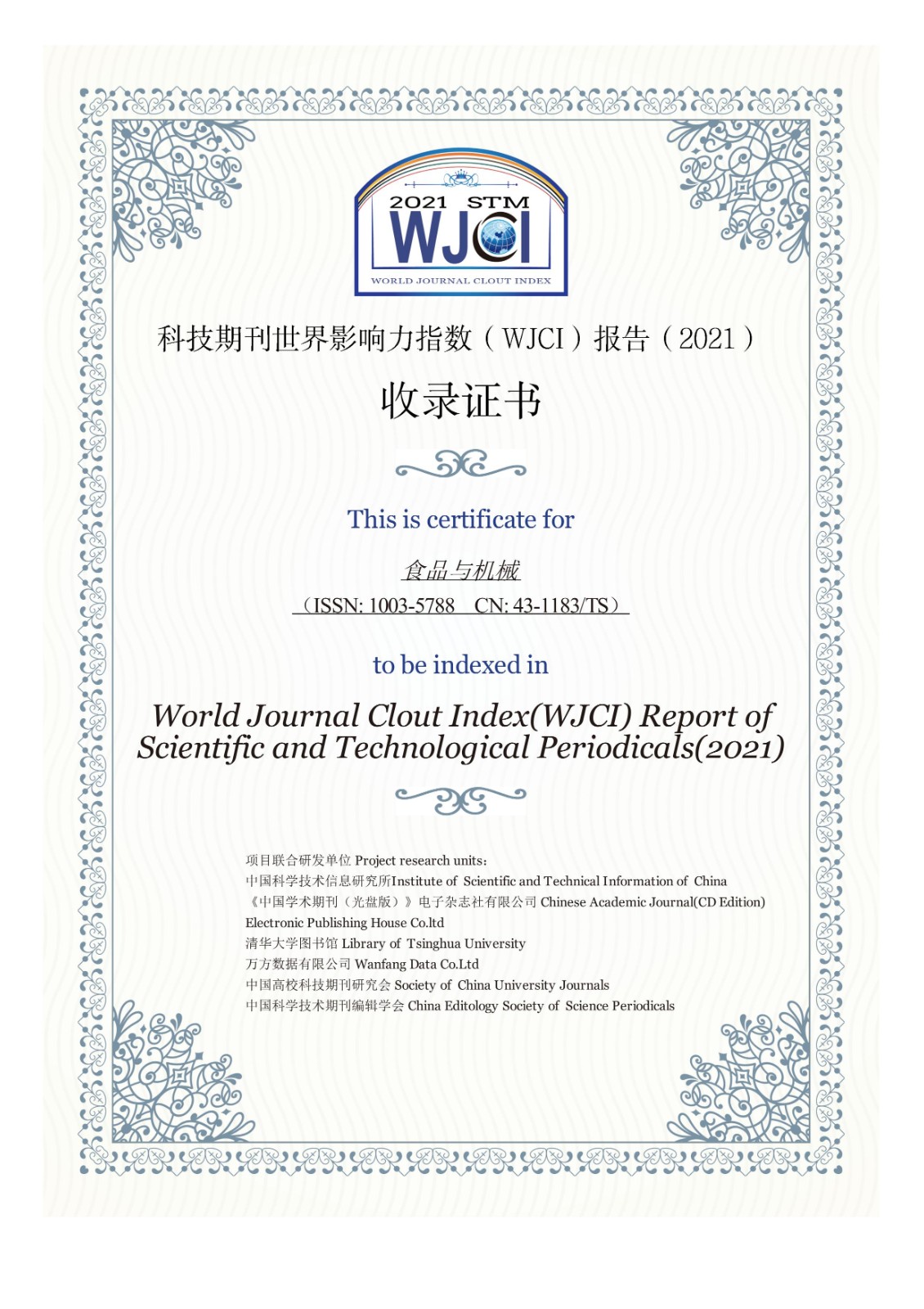
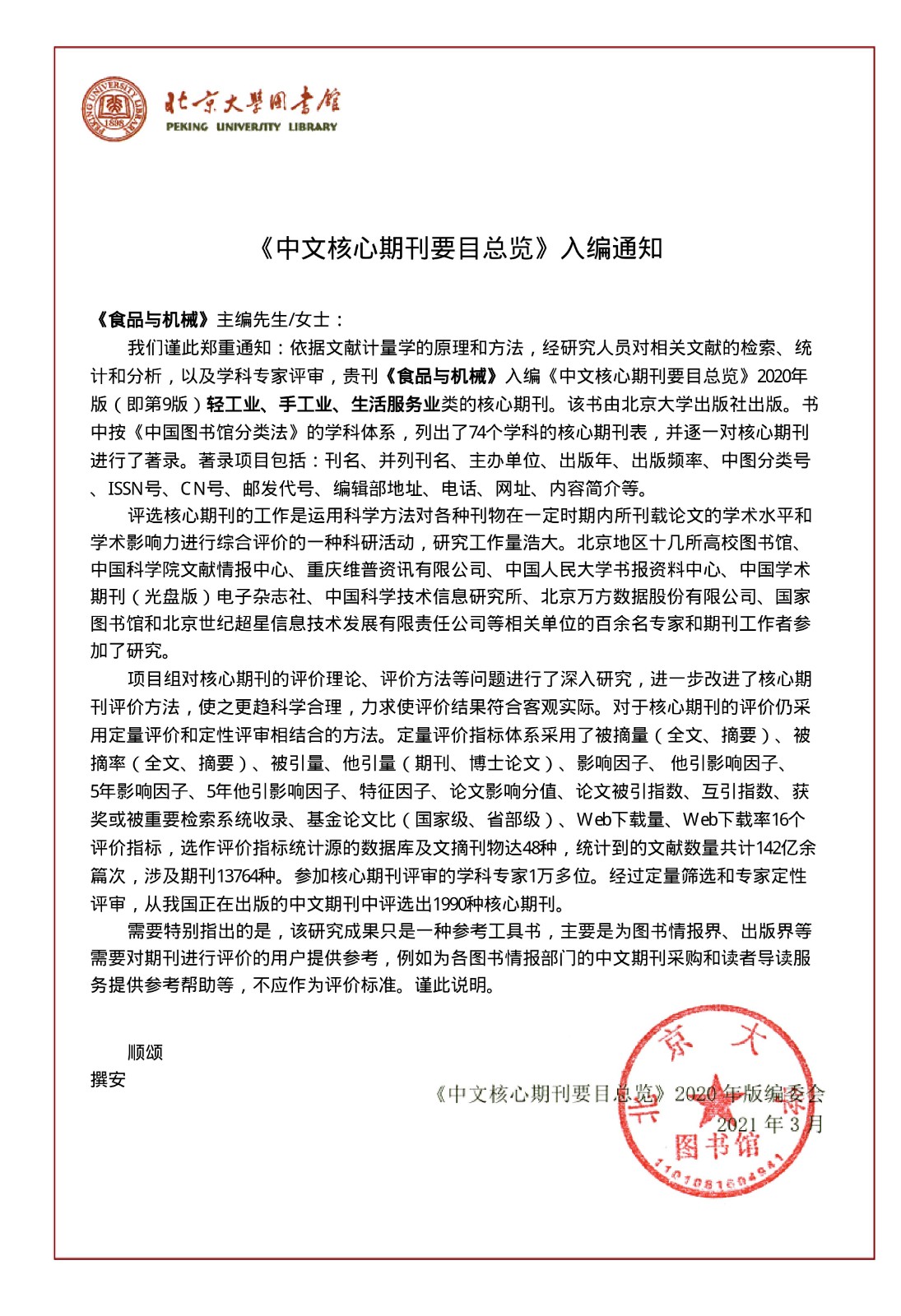
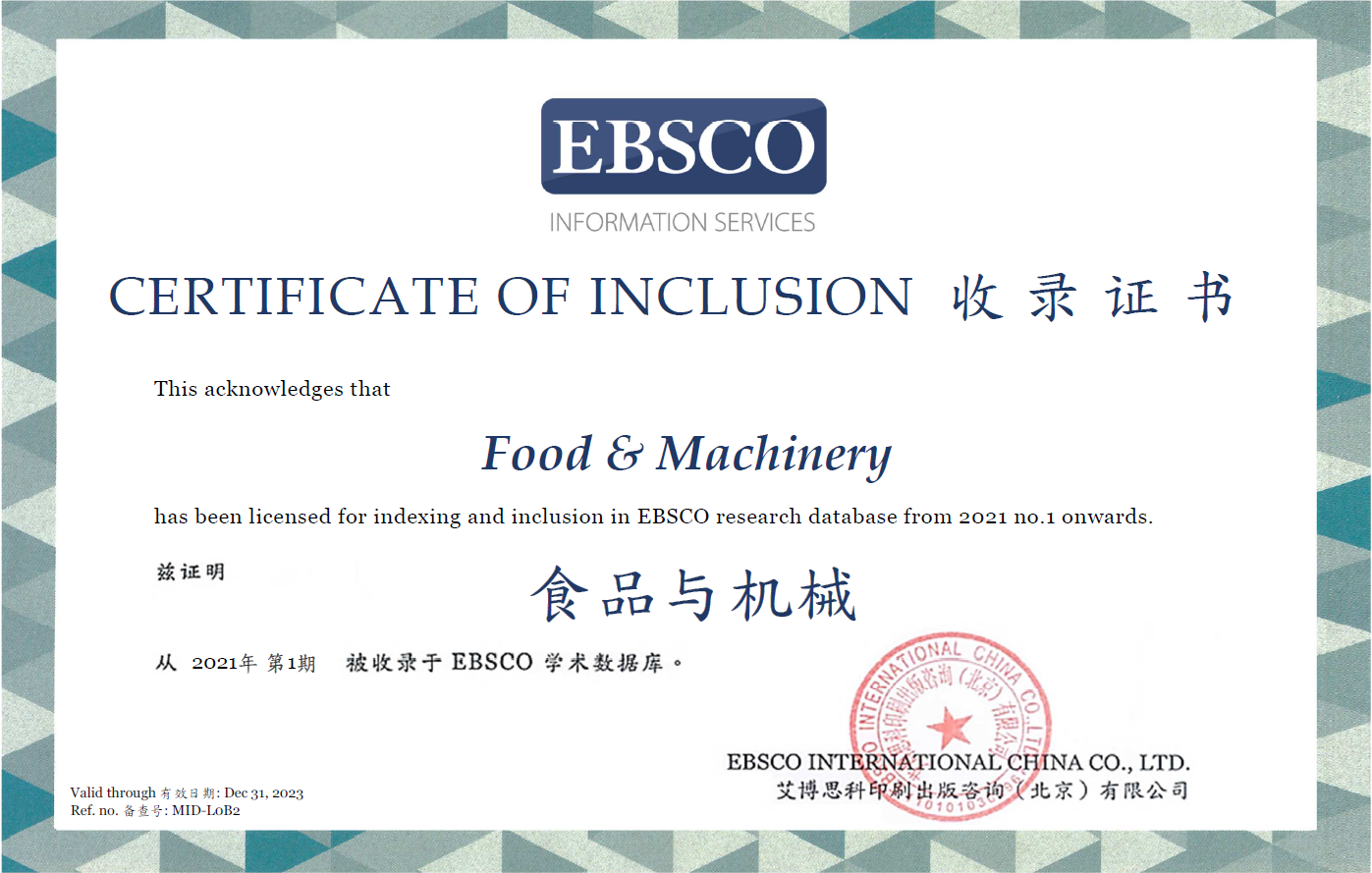
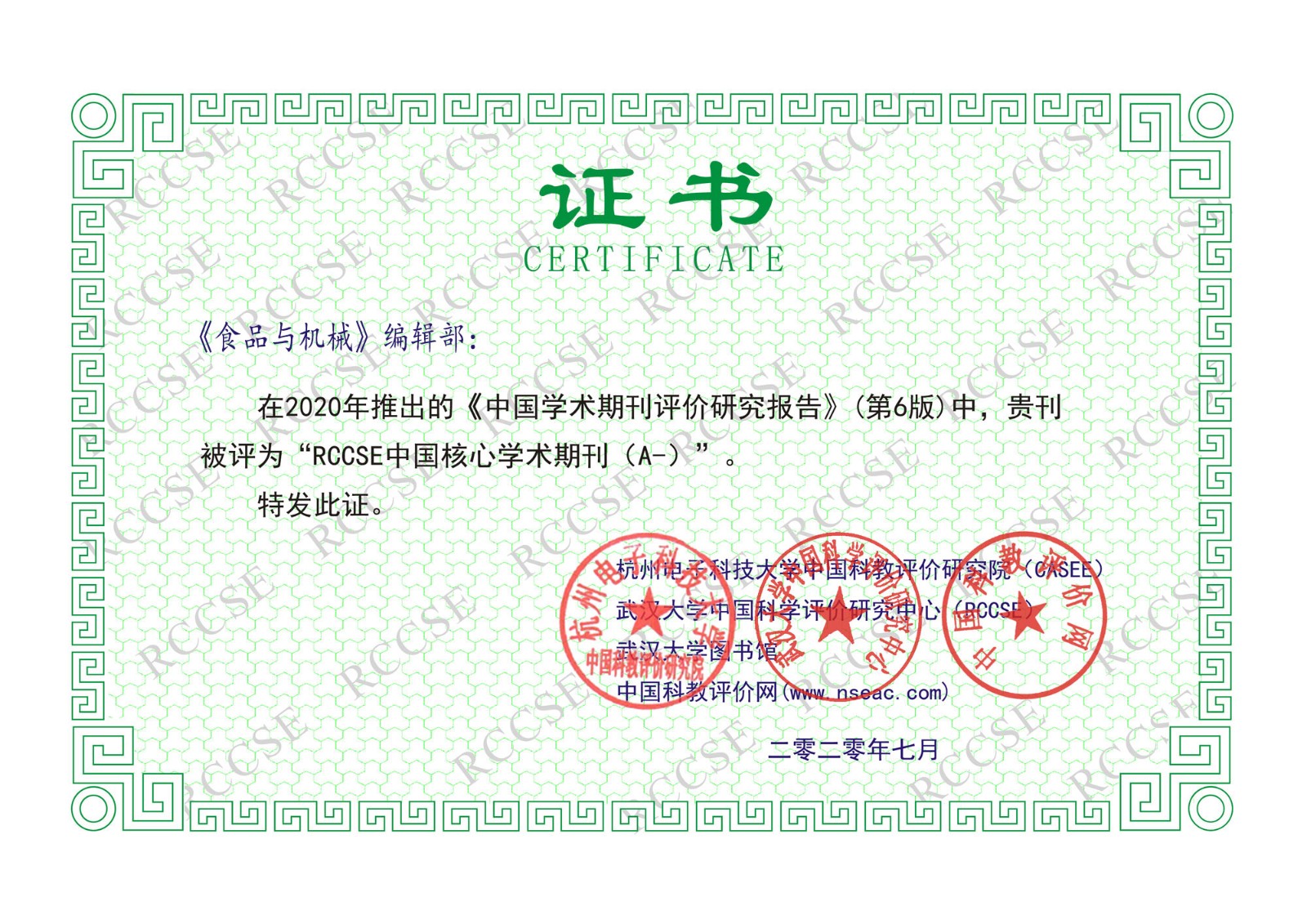
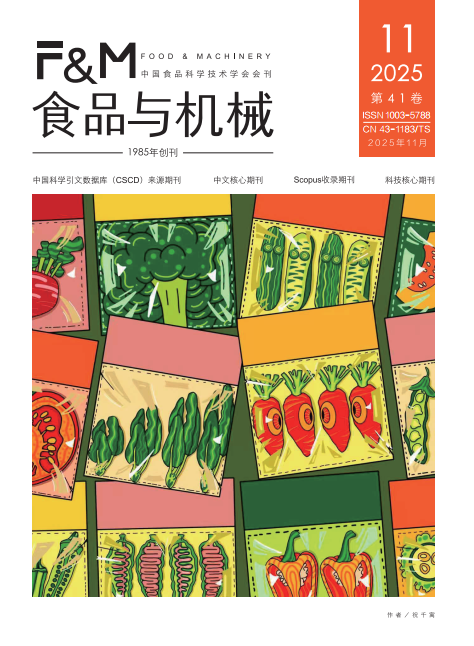
 Quick search
Quick search External Links
External Links